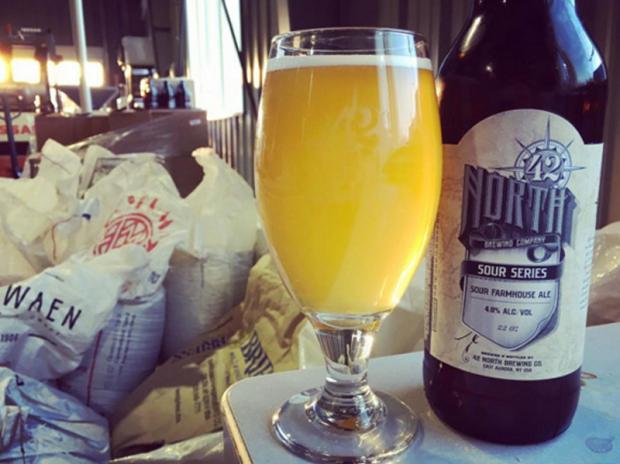WNY: Embrace the Funk
While it is known that beer is nearly as old as civilization, the ever-growing craft-beer revolution taking place in America has been changing the palate of beer drinkers for only a few decades. Once Prohibition ended and beer-making became a more industrialized process, important characteristics of beer began to be minimized for the sake of commercial popularity. Unique imperfections that defined a brewer or a style were cast aside for sterilized, corn-sugared, over-filtered mediocrity.
Traditionally, though, brewing wasn’t always such a sanitary process. Despite a brewer’s best efforts, something unintended often crept into a batch of beer. Impure yeast strains, imperfect sealing—any number of things could affect the end result of a beer. Sometimes (especially in the case of sour beers) the brewer would have actually introduced some of the things that cause imperfections. In Belgium, some breweries would pump wort to attic rooms containing cooling troughs (called coolships), open the louvered windows, and let the wind carry in myriad ambient spores of all kinds to settle in. Allowing the wort contact with the open air inoculates it with various wild yeasts and bacteria which leads to complex, effervescent beers, with distinct flavors that might resemble white wine in some ways, but were often more intense.
As the food industry became dependent upon pasteurization, so too did the brewing industry, and Congressional standards based on these sterilization standards all but killed sour beers in 20th-century America. Using commodified ingredients and cultivated yeast, brewers began to produce beers that grew ever closer to the middle—consistently average in order to ensure marketability.
As brewers entered the 21st century, there was a growing interest in more flavorful and intricate beers; both from consumers, and from the brewers themselves. This lead more experienced brewmasters to try their hand at European influenced beers, which included the traditional styles of the Belgian monks. Brewers began to introduce some of the less predictable yeasts, most notably, Brettanomyces, and the beers were also fermented with bacteria such as Lactobacillus and Pediococcus. The resulting brews are left unfiltered and produce scents reminiscent of an old farmhouse. The flavors are often a bit salty and puckering, which is how they fall into the very general description of “sour.”
While Buffalo’s beer explosion has just recently begun, brewers are already maturing to keep pace with more established beer cities like Fort Collins and West Coast breweries, such as Russian River. 42 North Brewing, located just south of Buffalo in East Aurora, is among the local breweries that are leading the march toward more as adventurous styles.
“We had a brewer who used to work with Wyeast,” explains 42 North’s chief brewing officer, Clay Keel. “He helped to create these yeast strains that can only be described as ‘wild.’” Along with Clay, Ukraine-native Naz Drebot, and son of East Aurora Alex Sowyrda are working to develop a line of beers that utilizes these yeast strains and other ingredients to produce unique and interesting flavors that are not commonly found in Buffalo beers.
In just the few months that 42 North has been open, their beers have caused quite a stir in the local market. They recently released bottles of their first sour beer, American Sour Ale. The cloudy golden beer is bottle conditioned, so the yeast is still hard at work while the bottles rest on the shelves. They are already fermenting another batch, along with a farmhouse style using saison yeast and darker malts, and a third using champagne yeast and spices.
“To be completely honest with you, we’re in the experimental stage. We’re by no means experts in this,” Keel says. “We know what we want to play with and we have enough information to do it safely. If people like them, we can start using more barrels and sour-only fermenters. There is a lot of potential.”
Keel and his crew have certainly begun to carve a niche for themselves in the market. As the tastes of Buffalo beer enthusiasts mature, the demand for these sour beers increases, and there is a well-established movement toward local sustainability, so craft beer drinkers will be seeking local beer that will suit their particular tastes. It says a lot about the city itself that Buffalo is joining the ranks of other locations that have long-established craft beer cultures in such a rapid fashion. 42 North, along with other breweries like Southern Tier, Community Beer Works, Resurgence Brewing, Rusty Nickel, and Woodcock Brothers, are experimenting with sour beers and barrel-aged beers, demonstrating an incredible acumen at such a relatively young ‘age.’ Several of these fantastic brewers will have samples of their sour beer at The Brewer’s Invitational hosted by the Buffalo Niagara Brewers Assoxiation at Pettibone’s Grill on April 2. Tickets and information can be found at buffaloniagarabrewersassociation.org.
42 NORTH BREWING COMPANY
25 Pine St, East Aurora
42northbrewing.com
Instagram / Twitter / Facebook
 The Public’s weekly beer column is a collaboration with the Buffalo Niagara Brewers Association.
The Public’s weekly beer column is a collaboration with the Buffalo Niagara Brewers Association.

